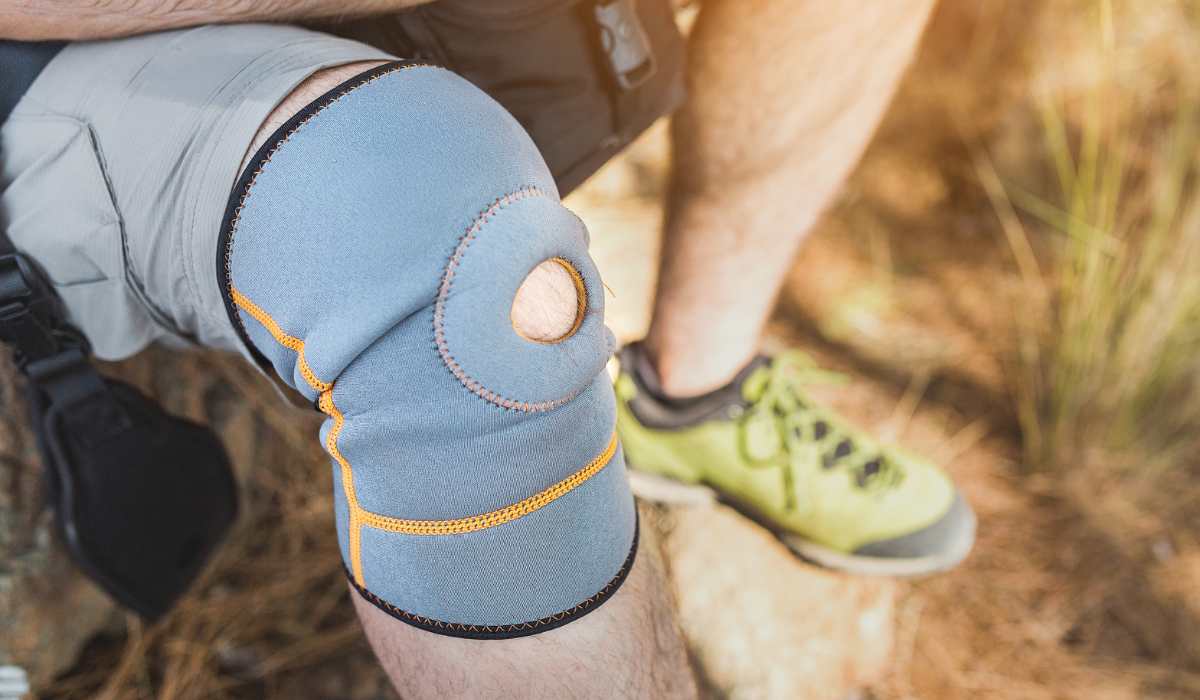The Best Hiking Knee Braces for Outdoor Adventures
When selecting a hiking knee brace, there are many aspects to take into account for ensuring maximum support and safety for your knees. As an avid hiker, you understand that maintaining healthy joints is essential for conquering challenging trails and enjoying the great outdoors.
In this comprehensive guide, we will delve into the various aspects of selecting the perfect hiking knee brace. We’ll discuss what features to look for when choosing a brace, as well as outline the benefits of wearing one while traversing rough terrain.
Furthermore, we will explore different types of knee braces available on the market and provide guidance on how to properly measure your knees for a secure fit. In addition, our specialist advice can help you make an educated decision when selecting a knee brace that meets your requirements.
Last but not least, we’ll share some advice on caring for and maintaining your chosen hiking knee brace so that it remains effective throughout many adventures. Finally, our top-rated recommendations will help narrow down your search and simplify the process of finding the best hiking knee braces tailored specifically to enhance your outdoor experiences.
Table of Contents
1. What to Look for in the Best Hiking Knee Braces

If you’re an outdoor enthusiast who loves exploring planet Earth, chances are you’ve experienced knee pain at some point during your adventures. No matter the cause – be it an old injury or just the strain of trekking on uneven surfaces – having a suitable knee brace can drastically reduce any pain and unease you may experience while out in nature. In this section, we’ll discuss what features to look for when searching for the best hiking knee braces.
Support and Stability
A knee brace’s main purpose is to provide support and stability while on the trail, so look for one that offers adjustable straps or closures to tailor it specifically to your needs. When looking for a suitable brace, consider one that offers adjustable straps or closures so you can customize its fit according to your needs. This will ensure that your kneecap remains stable even during rigorous activities like climbing steep hills or traversing rocky paths.
Comfort and Breathability
A comfortable knee brace is essential if you plan on wearing it throughout long hikes or treks. Opt for materials that are lightweight yet durable enough to withstand wear and tear from regular use outdoors such as neoprene or spandex blends with moisture-wicking properties which help keep sweat away from your skin preventing chafing irritation caused by friction between fabric and body heat build-up inside padding area providing added comfort, especially in hot weather conditions.
Ease of Use
- Select a design that allows easy application without requiring assistance – slip-on styles with Velcro fasteners tend to be more user-friendly than those featuring complex lacing systems;
- Pick one specifically designed for hikers, offering additional features like anti-slip silicone strips to prevent slipping down the leg during movement, making sure it stays securely in place throughout the entire hike.
Compression and Pain Relief
A good hiking knee brace should provide adequate compression to help reduce pain caused by conditions like a runner’s knee, arthritis, or tendonitis. Compression helps improve blood circulation in the area, which can aid in faster recovery and alleviate inflammation. Look for braces with graduated compression that targets specific areas of your knees where you need it most.
Durability and Quality Construction
Invest in a reliable, high-performance knee brace constructed from durable materials to ensure long-lasting use. Check for reinforced stitching at stress points and opt for brands known for their reliability and performance so you can trust your gear will last through many adventures.
When searching for the optimal hiking knee braces, factors such as comfortability, breathability and support must be taken into account. Additionally, you should also look into how adjustable they are in order to ensure that your brace fits correctly. Considering the factors mentioned, let’s explore the advantages of having a knee brace when trekking.
Key Points To Remember:
When searching for the best hiking knee braces, it’s important to consider support and stability, comfort and breathability, ease of use, compression and pain relief, as well as durability and quality construction. Look for adjustable straps or closures to customize the fit according to your needs; opt for lightweight yet durable materials with moisture-wicking properties; select a design that allows easy application without requiring assistance; choose graduated compression targeting specific areas of your knees where you need it most; invest in high-quality brands known for their reliability and performance.
Click to read about Best Hiking Backpacks for Big Guys
2. Benefits of Wearing a Knee Brace While Hiking
Exploring nature’s wonders on foot can be an arduous task, particularly for your knees. That’s where hiking knee braces come in. These supportive devices offer numerous benefits that make your hikes more enjoyable and less painful. Let’s take a closer look at some of these advantages:
A. Pain Relief
Knee pain is a common issue for hikers, especially those with pre-existing conditions like runner’s knee. Wearing a knee brace while hiking helps reduce pain by providing support and stability to the joint, allowing you to hike longer distances without discomfort.
B. Injury Prevention
By stabilizing the knee cap and surrounding muscles, hiking knee braces help prevent injuries caused by sudden twists or overextension during strenuous activities such as climbing steep inclines or descending rocky trails.
C. Improved Confidence
- By having your knees securely held in place, you can relax and savor the experience of hiking without fretting over potential injuries or uneasiness.
- This confidence boost may even encourage you to tackle more challenging trails.
D. Enhanced Performance
The added support from a quality knee brace can improve overall leg strength and endurance during long hikes, helping you maintain proper form throughout the journey.
E. Easing Your Way Back into Hiking After an Injury
If you’ve recently suffered from a knee injury or surgery, wearing a hiking knee brace will provide additional protection as you ease back into outdoor adventures. This guide on hiking after a knee injury is an excellent resource for those looking to get back on the trail safely.
In summary, wearing a knee brace while hiking can significantly enhance your overall experience by reducing pain, preventing injuries, and boosting confidence. So why not give it a try during your next outdoor adventure?
Wearing a knee brace while hiking can provide added support and stability, making the experience more enjoyable. Moving on to types of knee braces for hiking, there are many options available that cater to different needs and preferences.
Key Points To Remember:
Hiking knee braces offer several benefits, including pain relief and injury prevention. They also improve confidence and enhance performance during long hikes while easing the way back into hiking after a knee injury or surgery. So why not give them a try on your next outdoor adventure?
3. Types of Knee Braces for Hiking

For hikers, a variety of knee braces are available to suit different needs and preferences. Understanding the various options will help you choose the best brace for your specific requirements. In this section, we’ll explore some common types of knee braces designed specifically for hikers.
a) Compression Sleeves
Compression sleeves provide gentle support and compression around the entire knee joint without limiting mobility. They can help reduce pain caused by inflammation or swelling while also improving circulation in the area. These lightweight sleeves are perfect for those with mild knee issues or as a preventive measure during long hikes.
b) Wraparound Braces
A wraparound brace is an adjustable strap-based support system that wraps around your leg above and below the kneecap, providing targeted compression where needed most. This type of brace is ideal for individuals experiencing runner’s knee or patellar tendonitis since it helps stabilize the kneecap and alleviate pressure on surrounding tissues.
c) Hinged Braces
If you require more advanced support due to a previous injury or chronic instability, a hinged brace might be your best option. These braces feature metal hinges on either side of your leg which limit excessive lateral movement while still allowing normal flexion and extension motions— perfect if you’re recovering from an ACL tear or meniscus damage.
d) Patellar Stabilizing Braces
For those with patellar tracking issues or a history of kneecap dislocations, patellar stabilizing braces are designed to keep the kneecap in its proper position during movement. These braces typically feature a hole for the kneecap and additional straps that help secure it in place.
e) Custom-Made Braces
In some cases, you may require a custom-made brace tailored specifically to your unique needs and body shape. A medical professional can take precise measurements of your leg and create a one-of-a-kind support system that offers optimal protection and comfort on the trail.
To choose the best hiking knee brace for your situation, consider factors such as your level of activity, the severity of pain or injury, personal preferences regarding materials and design, as well as any advice from healthcare professionals familiar with your specific condition. Knee braces can provide extra support and pain relief, making them the perfect choice for challenging hikes or long distances. Don’t forget to bring along your trekking poles for additional stability on rough terrain.
When picking a knee brace for hiking, there are numerous possibilities. When selecting a brace, factors such as activity level and body type should be taken into account to ensure optimal support. Now let’s take a look at how to measure your knees for an appropriate fit in the next heading.
Key Points To Remember:
This section explores the different types of knee braces available for hikers, including compression sleeves, wraparound braces, hinged braces, patellar stabilizing braces and custom-made options. Each type caters to specific needs and preferences depending on factors such as level of activity or severity of pain/injury. Choosing the right brace can provide extra support and pain relief during challenging hikes or long distances.
Click to read about 10 Amazing Hiking Date Ideas
4. How to Measure Your Knees for a Knee Brace
Finding the perfect fit is essential when it comes to choosing a hiking knee brace. An ill-fitting brace can cause discomfort and may not provide the support you need during your outdoor adventures. To ensure you get the best fit for your needs, we’ll guide you through the process of measuring your knees correctly so that you can find the ideal size knee brace.
A. Gather Necessary Tools
To measure your knees accurately, you will need:
- A flexible measuring tape (preferably one designed for body measurements)
- A pen or pencil and paper to record measurements
- Comfortable clothing that allows easy access to your knees (shorts are ideal)
B. Take Measurements in Three Key Areas
You’ll want to take three key measurements around different parts of your knee: above, below, and directly over the kneecap itself.
- Above the Kneecap: While standing with legs straight but relaxed, wrap the measuring tape around your thigh about six inches above the center of your kneecap. Record this measurement as “Thigh Circumference.”
- Below the Kneecap: Measure around your calf about six inches below the center of your kneecap. Record this measurement as “Calf Circumference.”
- Knee Center: Wrap the measuring tape directly over the center of your kneecap while keeping a slight bend in your knee (about 30 degrees). Record this measurement as “Knee Circumference.”
C. Compare Measurements to Size Charts
Once you have taken all three measurements, refer to the size chart provided by the manufacturer of your desired hiking knee brace. Each brand may have slightly different sizing guidelines, so it’s essential to use their specific chart for accurate results.
If you find that your measurements fall between two sizes, consider how tight or lose you prefer a knee brace to fit and choose accordingly. Some people prefer a snugger fit for maximum support, while others opt for more breathability and comfort with a looser fitting brace.
Taking these steps will ensure that you select an appropriately sized hiking knee brace that provides optimal support and comfort during all of your outdoor adventures.
Measuring your knees for a knee brace is an important step in finding the right fit and ensuring maximum comfort. Selecting the appropriate knee brace for your requirements is critical to guarantee optimal support.
Key Points To Remember:
To find the perfect fit for a hiking knee brace, it is essential to measure your knees accurately. You’ll need a flexible measuring tape and comfortable clothing that allows easy access to your knees, then take three key measurements around different parts of your knee: above, below, and directly over the kneecap itself. Finally, compare these measurements to size charts provided by manufacturers and choose accordingly based on how tight or loose you prefer a knee brace to fit.
5. Tips on Choosing the Right Knee Brace

When it comes to picking a knee brace that will offer the most support and comfort when hiking, there are some points you should think about. Think about these tips when looking for the ideal knee brace to ensure you have optimal support and comfort while hiking.
A. Determine Your Needs
First and foremost, think about why you need a knee brace for hiking. Are you recovering from an injury? Do you have chronic pain or instability issues? Or do you simply want extra support during long hikes? Knowing your specific needs will help narrow down your options and guide your decision-making process.
B. Choose the Right Type of Brace
For maximum stability or more flexibility and warmth, consider different types of knee braces. Based on your individual needs and preferences, choose between hinged braces for maximum stability or compression sleeves for more flexibility and warmth.
C. Prioritize Comfort and Fit
- Fabric: Look for breathable materials like neoprene or spandex that wick away moisture to keep your skin dry during sweaty hikes.
- Sizing: Make sure to measure your knees accurately (as discussed earlier) so that the brace fits snugly without being too tight or loose.
- Closures: Consider adjustable straps if necessary so that they can be customized according to how much support is needed at any given time during a hike.
D. Check Reviews & Recommendations
To ensure that other users have had positive experiences with the knee brace you’re considering, read online reviews and ask for recommendations from friends or fellow hikers. You can also consult your doctor or physical therapist for professional advice on which hiking knee braces are best suited to your needs.
E. Consider Additional Features
Some hiking knee braces come with extra features like patella stabilizers, side stays, or pockets for ice packs. While these may not be necessary for everyone, they could provide added benefits depending on your specific situation.
By following these tips and doing thorough research before making a purchase decision, you’ll be well-prepared to find the perfect hiking knee brace that meets all of your support and comfort requirements during outdoor adventures.
When selecting a knee brace for your next trek, bear in mind the elements laid out in this piece. With proper care and maintenance, you can ensure that your hiking knee brace will provide long-lasting support on every outdoor adventure. Next up is a look at how to properly care for and maintain your new knee brace so it lasts as long as possible.
Key Points To Remember:
When selecting a hiking knee brace, it is important to determine your needs and choose the right type of brace for maximum support. Prioritizing comfort and fit by considering fabric, sizing, and closures is also crucial. Checking reviews and recommendations as well as considering additional features like patella stabilizers can help you find the perfect knee brace for your outdoor adventures.
Click to read about Best Fall Hikes in Washington: Top Trails for Autumn Colors
6. Care and Maintenance of Your Hiking Knee Brace
Taking proper care of your hiking knee brace is essential to ensure its longevity and effectiveness during your outdoor adventures. Follow these simple tips for maintaining your knee brace in top condition:
- Cleaning: After each hike, gently clean the knee brace with a damp cloth or sponge using mild soap and water. Avoid soaking it completely, as this may damage the materials. Rinse thoroughly and allow it to air dry before storing.
- Inspecting: Regularly inspect your knee brace for any signs of wear or damage, such as fraying straps or loose hinges. If you notice any issues, consider replacing the affected parts or purchasing a new brace altogether.
- Avoid Excessive Heat: Do not expose your hiking knee braces to excessive heat sources like direct sunlight, radiators, or heated car interiors for extended periods. High temperatures can weaken the materials over time.
- Drying Properly: Always let your knee brace air dry after cleaning; never use a dryer machine as it could cause shrinkage or warping of the material components.
- Frequent Adjustments: Make sure you regularly adjust the fit of your hiking knee braces so they remain snug yet comfortable on every hike. This will help prevent unnecessary strain on both knees and joints while providing optimal support throughout all terrains.
In addition to these maintenance tips, be mindful that some manufacturers offer warranties on their products – always check if yours does too. This way, you’ll have peace of mind knowing that should anything go wrong with your purchase within the warranty period (usually around six months), replacement parts or even an entirely new brace will be provided at no extra cost.
By following these care and maintenance guidelines, you can ensure that your hiking knee braces remain in excellent condition for many outdoor adventures to come. Happy hiking.
Proper care and maintenance of your hiking knee brace are essential for the longevity of the product, so make sure to take good care of it. Next, we’ll look at some top-rated hiking knee braces available on the market today.
Key Points To Remember:
To maintain the longevity and effectiveness of your hiking knee brace, it is important to clean it after each hike with mild soap and water, inspect for any signs of wear or damage, avoid exposing it to excessive heat sources, air dry properly after cleaning, and make frequent adjustments. Checking if your manufacturer offers warranties on their products can also provide peace of mind in case anything goes wrong within the warranty period.
7. Top-Rated Hiking Knee Braces

For those seeking the highest-rated hiking knee braces, PowerLix Compression Knee Sleeve is one of the best choices. Here are some of the top-rated options available on the market today:
- PowerLix Compression Knee Sleeve: This highly popular and well-reviewed knee brace offers excellent support and comfort while hiking. Its breathable fabric ensures that your knees stay cool during those long treks.
- McDavid Patella Strap Knee Brace Support: Designed specifically for hikers with patellar tendonitis or jumper’s knee, this strap provides targeted compression to alleviate pain and discomfort during hikes.
- Ultra Flex Athletics Knee Compression Sleeve Support: With its anti-slip silicone grip wave design, this brace stays in place even during intense activities like trail running or climbing. It also features a unique 4-way stretch capability for maximum flexibility.
- EXOUS Bodygear EX-701 Performance Stabilizing Knee Brace Protector: Offering exceptional stability through its four-way compression system, this knee brace is perfect for those who need extra support during their hikes. The non-slip design ensures it stays in place throughout your adventure.
- Bracoo Knee Support with Open-Patella Design: This adjustable knee brace features an open-patella design to relieve pressure on the kneecap while providing ample support and stability. It’s ideal for hikers with a history of knee injuries or chronic pain.
When selecting a hiking knee brace, take into account factors such as coziness, breathability, robustness and amount of backing for your individual needs. If you’re experiencing knee pain, a proper knee brace can help alleviate discomfort and prevent further injury. Knee braces, knee straps, and hinged knee braces are all great options for relieving knee pain while hiking. Additionally, using hiking poles can provide extra support and reduce the impact on your knees, especially when hiking downhill. Happy trails.
Click to read about 7 Tasty Hiking Lunch Ideas for Your Next Outdoor Excersion
FAQs About Hiking Knee Braces
Which Knee Brace is Best for Hiking?
The best knee brace for hiking depends on individual needs and preferences. Generally, hinged braces provide excellent support and stability, while compression sleeves offer comfort and mild support. The McDavid 429X Hinged Knee Brace and the PowerLix Compression Knee Sleeve are popular choices among hikers.
Should You Wear Knee Braces Hiking?
Wearing a knee brace while hiking can be beneficial if you have a history of knee injuries or experience pain during hikes. A well-fitted brace provides support, reduces strain on joints, improves stability, and prevents further injury. Consult with a medical professional before using a knee brace to ensure it’s suitable for your specific needs.
How Can a Special Knee Brace Help the Hiker?
A specialized hiking knee brace helps by providing targeted support to weak or injured areas of the knees. It also aids in reducing inflammation, improving circulation, enhancing joint mobility, and preventing re-injury during strenuous activities like uphill climbs or downhill descents. Ultimately, it contributes to overall comfort and performance while exploring trails.
How Do I Stop My Knees from Hurting When Hiking?
To prevent knees from hurting when hiking, choose appropriate footwear with good arch support, use trekking poles to reduce impact, practice proper walking techniques, strengthen leg muscles through regular exercise, and consider wearing a knee brace for added support. Additionally, take breaks when needed and avoid overexerting yourself on challenging terrains.
Conclusion
Knees can often be prone to harm while on a hike, making knee protection essential for any enthusiastic trekker. That’s why investing in the best hiking knee braces is crucial for any hiker looking to protect their knees and enjoy the great outdoors without discomfort or pain. Identifying the correct characteristics, accurately sizing your knees and selecting an appropriate brace are all essential elements when deciding on a knee brace for hiking.
The benefits of wearing a hiking knee brace include added support and stability, reduced pain and inflammation, improved circulation, and enhanced performance on the trail. Proper care and maintenance will ensure that your chosen brace lasts longer and provides optimal protection over time.
If you’re ready to take on new adventures with confidence while protecting your knees from injury or strain, check out SunWaterDirt’s selection of top-rated hiking knee braces today!







